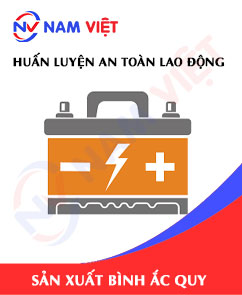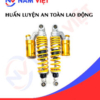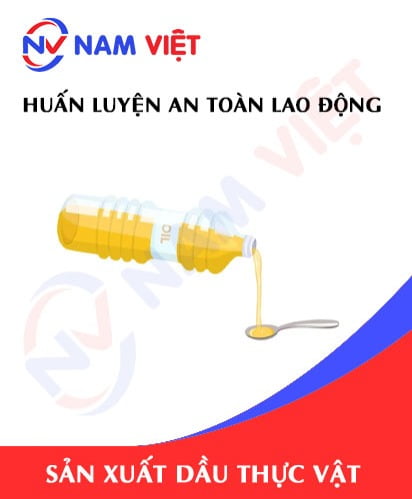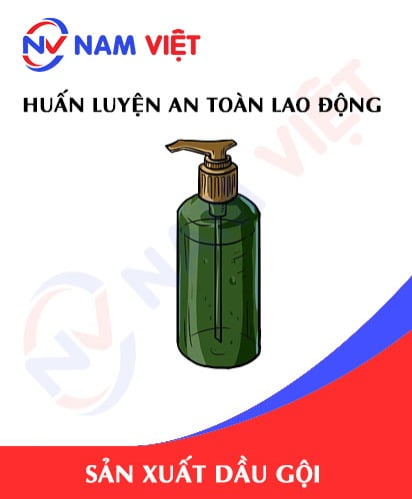Occupational Safety Training for Battery Manufacturing
99,000 ₫
Note: The above price is calculated per person and may vary depending on the number of trainees participating in the course and market fluctuations. For more accurate pricing information, please refer to the price list or contact our consultants directly.
Occupational safety is an important issue in battery manufacturing factories and needs to be addressed promptly to ensure the health and safety of workers, as well as to enhance the reputation of businesses. The Occupational Safety Training course is an effective solution to raise awareness about accident prevention for workers involved in battery production.
Table of Contents
Toggle1. Overview of Batteries
a. What is a Battery?
A battery is an electrochemical energy storage device composed of cells, used to supply power for mobile devices, electric vehicles, uninterruptible power supplies (UPS), and many other applications. The primary function of a battery is to store energy chemically and convert it into electrical energy when needed.
Batteries are typically made up of one or more electrochemical cells enclosed in a leak-proof casing. These electrochemical cells contain electrodes — a positive electrode and a negative electrode — immersed in an electrolyte solution (such as sulfuric acid in lead-acid batteries). When connected in a circuit, an electrochemical reaction occurs between the electrodes to generate electrical current.
Common types of batteries include:
- Lead-acid batteries: Widely used in cars, motorcycles, UPS systems, and other household devices.
- Lithium-ion batteries: Used in mobile devices such as smartphones, laptops, tablets, and electric vehicles.
- Nickel-metal hydride batteries: Commonly found in consumer electronics like cameras and electronic toys.
Each type of battery has different characteristics in terms of capacity, lifespan, and performance, suitable for specific applications. Proper management and maintenance of batteries are essential to ensure their longevity and performance.

b. Machinery for Battery Production
- Moulding machines: Used to shape plastic or metal parts of batteries. For example, these machines can mold battery casings from heat-resistant plastic.
- Wrapping machines: Used to wrap protective and insulating layers around batteries to safeguard and enhance the safety of the final product.
- Electrolyte filling machines: Machines that fill electrolyte solutions (such as sulfuric acid) into batteries.
- Assembly machines: Used to assemble the components of batteries, including electrodes, conductors, and other parts.
- Testing and inspection machines: Equipment used to check the quality and performance of batteries after production to ensure they meet safety and quality standards.
- Charging machines: For rechargeable batteries, these machines recharge batteries before packaging and distribution.

c. Battery Manufacturing Companies in Vietnam
In Vietnam, there are several well-known battery manufacturing companies. Below are some notable enterprises in this industry:
- Southern Battery Joint Stock Company (Pinaco): One of Vietnam’s leading companies in battery and cell production. Pinaco is famous for products like Dong Nai batteries.
- Tia Sang Battery One Member Limited Liability Company: A reputable company manufacturing batteries for motorcycles, cars, and industrial equipment.
- Tia Sang Battery Joint Stock Company (Tibaco): Specializes in lead-acid batteries for motorcycles, cars, and industrial equipment. Tibaco also exports products to many countries worldwide.
- Hoa Binh Battery Group Joint Stock Company (Habaco): A major player in Vietnam’s battery manufacturing industry, focusing mainly on automotive and industrial batteries.
- GS Vietnam Battery Joint Stock Company: A joint venture between Japan’s GS Group and Southern Battery One Member Limited Liability Company (Pinaco), producing batteries for cars, motorcycles, and industrial devices.
These companies not only supply the domestic market but also export to many countries, contributing to the global standing of Vietnam’s battery industry.

d. Specific Jobs in Battery Manufacturing Plants
Group 1
- Executive director, deputy executive director, and department heads in battery manufacturing plants.
Group 2
- Safety officers: manage workplace safety, design safety procedures, supervise and enforce safe work practices among employees.
Group 3
- Plate casting: Casting positive and negative plates from lead, then coating them with lead oxide powder to produce active plates.
- Plate assembly: Assembling positive and negative plates together to form complete battery components.
- Battery assembly: Installing plates into battery cases, then filling acid and sealing the battery.
- Quality inspection: Conducting product quality tests such as voltage, capacity, and battery durability checks.
Group 4
- Office work, service, sales, marketing.
- Production management, quality management, human resource management, material management, financial accounting management.
- Research and development of new products, packaging and product design.
2. Overview of Occupational Safety Training for Battery Production
This article focuses on issues related to Group 3, because Group 3 consists of workers directly involved in production and exposed to the highest occupational safety risks. For information on other groups, see here.
a. What is Group 3 Occupational Safety Training?
- Group 3 occupational safety training consists of sessions aimed at raising awareness of workplace accident prevention among workers.
- This training helps workers recognize and avoid hazards, reducing the risk of accidents during work.
REGISTER FOR OCCUPATIONAL SAFETY TRAINING SERVICE
b. Training Duration
Initial safety training duration:
- The total training time must be at least 24 hours, including examination time.
- 8 hours of theory on policies and laws related to occupational safety and hygiene.
- 8 hours of theory on basic occupational safety and hygiene knowledge.
- 4 hours of theory on specialized training content.
- 2 hours of practical training on specialized content.
- 2 hours for theoretical final examination.
The safety training center will arrange the schedule into multiple sessions depending on workers’ availability. Typically, there are 6 sessions over 3 days, provided the company can arrange continuous training time.
Periodic safety training duration:
- Before the occupational safety card expires, workers wishing to renew it must attend periodic occupational safety training, with periodic training time being at least 50% of the initial training time.
Explanation: the total periodic occupational safety training time must be at least 12 hours, including examination time. After completing periodic training and passing the exam, workers will be reissued or extended their occupational safety card.
c. Training Content
| No. | TRAINING CONTENT | TRAINING DURATION (HOURS) | |||
| Total | Including | ||||
| Theory | Practice | Examination | |||
| I | System of policies and laws on occupational safety and hygiene | 8 | 8 | 0 | 0 |
| 1 | Overview of legal documents on occupational safety and hygiene. | 6 | 6 | ||
| 2 | Standards and technical regulations on occupational safety and hygiene. | 1 | 1 | ||
| 3 | Specific regulations from state management agencies on occupational safety and hygiene for new construction, expansion, or renovation of factories, facilities for production, storage, inspection of machinery, equipment, materials, and substances with strict safety and hygiene requirements. | 1 | 1 | ||
| II | Basic knowledge of occupational safety and hygiene | 8 | 8 | 0 | 0 |
| 1 | Basic knowledge about hazardous and harmful factors at the workplace. | 4 | 4 | ||
| 2 | Methods to improve working conditions. | 1 | 1 | ||
| 3 | Safety culture in production and business. | 1 | 1 | ||
| 4 | Rights and obligations of employers and employees; policies and regimes on occupational safety and hygiene; roles and responsibilities of safety network and hygiene staff. | 1 | 1 | ||
| 5 | Safety and hygiene regulations, safety signs, usage of safety equipment and personal protective equipment; first aid skills, occupational disease prevention. | 1 | 1 | ||
| III | Specialized training content | 6 | 4 | 2 | 0 |
| Comprehensive knowledge of machines, equipment, hazardous substances; risk analysis, evaluation, and management related to occupational safety and hygiene; safe work procedures for machines, equipment, and substances with strict safety requirements. | 6 | 4 | 2 | ||
| IV | Final safety training examination | 2 | 2 | 0 | 0 |
| Total | 24 | 22 | 2 | ||
See more training contents of 6 groups
d. Occupational Safety Card
After completing the occupational safety training and passing the exam, workers will be issued an occupational safety card (commonly called the occupational safety certificate for Group 3).
The Group 3 safety card clearly displays information such as full name, date of birth, specific job and work environment, training duration, official red stamp, and signature confirming training completion.
According to regulations on card issuance in Clause 2 of Article 24 of Decree 44/2016/ND-CP, there are two cases:
- If the employer and employee have a labor contract, the employer must sign, stamp, and countersign the safety card for the Group 3 trained worker after completing training and passing the exam.
- If the worker is freelance or temporary and does not have a labor contract, the training unit must sign, stamp, and countersign the safety card after the worker completes training and passes the exam.

3. Identifying Hazards Affecting Workers During Battery Production
- Exposure to hazardous chemicals: During battery production, chemicals such as sulfuric acid, lead, and other compounds may be used. Prolonged and improper exposure to these substances can harm workers’ skin, eyes, respiratory system, and digestive system.
- Risk of explosion and fire: During the electrolysis of sulfuric acid, there is a risk of explosion and fire if the acid solution and electrodes are not safely managed. Care must be taken to avoid these risks and ensure worker safety.
- Risk of mechanical injury: The use of heavy and bulky machinery and equipment in production can lead to injuries such as impacts, crushing, or falls.
- Risk from noise and vibration: Large machines and production processes can generate high noise levels and strong vibrations, affecting workers’ hearing and overall health if proper protective measures are not taken.
- Risk of heavy metal exposure: Repeated exposure to lead and other heavy metals can cause harm to the liver, kidneys, and nervous system.
- Risk of workplace accidents: Due to the nature of production processes, workplace accidents such as falls from heights, impacts, electric shocks, and other hazards may occur if strict occupational safety rules are not followed.

4. Safety Measures When Participating in Battery Production
When participating in battery production, safety measures are essential to protect workers’ health and safety. Below are some basic measures manufacturers should apply to minimize risks and hazards during battery production:
- Occupational safety training: Workers involved in battery production need training on safety procedures, potential hazards, and accident prevention methods.
- Use of personal protective equipment (PPE): Ensure workers have adequate and proper use of protective gear such as safety goggles, masks, gloves, protective jackets, and safety shoes to guard against chemicals, mechanical injuries, and other risks.
- Chemical safety management: Implement safety measures to manage and use chemicals like sulfuric acid safely, including proper storage, leak-proof equipment, and ventilation systems to minimize inhalation or skin contact risks.
- Control of explosion and fire risks: Apply safety controls such as managing and regulating electric current, using explosion-proof equipment, and ensuring safety when handling electrolytes and flammable chemicals.
- Machine inspection and maintenance: Ensure regular maintenance of machinery and equipment used in battery production to reduce the risk of damage and accidents caused by equipment failure.
- Noise and vibration management: Assess and control noise and vibration from equipment and production processes to protect workers’ hearing and overall health.
- Safe working conditions: Provide safe working conditions, including ventilation, natural lighting, and spacious work areas to reduce risks of injuries and accidents.
- Raising safety awareness: Promote awareness and improve safety consciousness among all employees, including reporting incidents and suggesting safety improvements.
- Regularly conduct occupational environment monitoring at factories to collect and analyze harmful factors affecting workers, then adjust to reduce risks and prevent occupational diseases.
These measures not only help minimize risks and hazards but also enhance production efficiency and maintain a safe and healthy working environment for employees in battery manufacturing.
5. Benefits of Occupational Safety Training in Battery Production
An Toàn Nam Việt offers your business the following benefits upon completing occupational safety training courses as regulated by Decree 44/2016/ND-CP on Occupational Safety and Health for companies and enterprises:
- Workers can identify potential risks of workplace accidents and take preventive measures to avoid them.
- Your business can establish risk prevention measures in production, operation, and maintenance processes.
- Reduce costs associated with workplace safety incidents.
- Uninterrupted production increases labor productivity and product quality.
- Compliance with occupational safety laws to avoid legal risks.
- Build credibility and professionalism, thereby enhancing your company’s brand.
Nam Việt’s training courses are the solution to prevent external hazards that individuals may face, helping them avoid dangers that could lead to injuries or even death.
REGISTER FOR OCCUPATIONAL SAFETY TRAINING SERVICE
6. Customer Feedback After Completing Occupational Safety Training in Battery Production
An Toàn Nam Việt has many years of experience accompanying businesses across Vietnam in general and southern provinces in particular. This responsibility is very precious to Nam Việt, so our Occupational Safety Training is increasingly professional. The motivation for Nam Việt’s growth comes from positive feedback and suggestions from our clients. Below are testimonials from partners we have served.
Bac Nam E&C Investment Construction Joint Stock Company
“My first time using An Toàn Nam Việt’s service, I was pleasantly surprised by the enthusiastic 24/7 support from the consulting team. Organizing the class was quick and convenient for our company. Thank you very much!”
Hoa Đất Construction and Trading Joint Stock Company
“Nam Việt’s service has greatly helped us simplify occupational safety and complete safety documentation for work processes. The consulting team is enthusiastic and timely in answering our questions. Five stars for Nam Việt.”
See more customer interviews after using An Toàn Nam Việt’s services
7. Occupational Safety Training Capability of An Toàn Nam Việt
An Toàn Nam Việt is a reputable and quality occupational safety training center in Vietnam today. Our training sessions are held continuously at factories, plants, or construction sites across all 63 provinces of Vietnam.
REGISTER FOR OCCUPATIONAL SAFETY TRAINING SERVICE
Occupational Safety Training License
- An Toàn Nam Việt has been inspected and certified by the Department of Safety under the Ministry of Labor – Invalids and Social Affairs to have the qualification for occupational safety and hygiene training activities. This further strengthens our training capabilities.

Materials and Lectures
- Before occupational safety training materials are included in safety training courses, they are reviewed and approved to ensure accuracy and effectiveness.
- Our instructors’ teaching methods align with An Toàn Nam Việt’s standards, developed by experts in occupational safety and hygiene training to maximize knowledge absorption.
Facilities
- Controlling classroom conditions that affect training increases teaching efficiency and learners’ knowledge retention.
- Our training facilities provide spacious classrooms that meet standards on area, lighting, training equipment, and more.
8. Nationwide Reputable and Quality Safety Training Center
At An Toàn Nam Việt, we prioritize occupational safety training with deep professional dedication. For us, imparting knowledge to help workers protect themselves provides them with safety tools for their livelihood and contributes to nation building.
To ensure effective training, we carefully prepare every detail, no matter how small—from tools, teaching equipment to curriculum, materials, sound, and lighting.
Our occupational safety instructors are experienced professionals, with research projects identifying hazards across industries and prevention methods.
Their lectures are practical and delivered in a vivid, easily understandable way to workers. This helps learners feel comfortable during training and absorb knowledge well. Our training content strictly follows Decree 44/2016/ND-CP.
Thus, workers learn many preventive measures against hazards and how to protect themselves, applying them appropriately in real work.
Our training center is proud to be a reputable and professional occupational safety training provider with advantages including:
- Competitive training costs while ensuring quality.
- Flexible training schedules to fit company production needs.
- Quick and lawful certification procedures for occupational safety training.
- Instructors with many years of professional experience.
- Classrooms controlled to optimize teaching efficiency and knowledge retention.
- Training materials tailored to occupational safety needs in enterprises.
- Dedicated and professional service supporting customers accurately and quickly.

9. Additional References for Occupational Safety Training Materials in Battery Production
- Occupational Safety Materials for Battery Production
- Occupational Safety Training Materials Set
- Occupational Safety Training Test Set
- Occupational Safety Curriculum for Battery Production
- Occupational Safety Multiple Choice Test for Battery Production
No comments yet















Review Occupational Safety Training for Battery Manufacturing
There are no reviews yet.